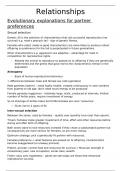Relationships
Evolutionary explanations for partner
preferences
Sexual selection
Darwin: SS is the selection of characteristics that aid successful reproduction (not
survival) e.g. male’s peacock tail – sign of genetic fitness.
Females who select males w good characteristics are more likely to produce robust
offspring so preference for the tail is perpetuated in future generations.
Other characteristics e.g. aggression are adaptive – advantage for male in
competition for reproductive rights.
- Allowed the animal to reproduce so passed on to offspring if they are genetically
determined and the genes that gave rise to the characteristics remain in the
population
Anisogamy
- Basis of human reproductive behaviour
= differences between male and female sex cells (gametes)
Male gametes (sperm) – small highly mobile, created continuously in vast numbers
from puberty to old age, don’t need much energy to be produced
Female gametes (eggs/ova) – relatively large, static, produced at intervals, limited
number of fertile years, require investment of energy
So no shortage of fertile males but fertile females are rarer ‘resources’.
Gives rise to 2 types of SS
Inter-sexual selection
Between the sexes, used by females – quality over quantity (ova rarer than sperm).
Trivers: females make greater investment of time, effort and other resources before
during and after birth of offspring.
Both sexes stand to lose resources invested if they chose a substandard partner but
consequences are more serious for females, so are more choosy.
Optimum strategy: pick a genetically fit partner with resources.
Females preference = what features are passed on to offspring, characteristics
become exaggerated (a runaway process).
Protect, provide, control food and resources for survival = Muscular strength in
evolutionary past, now occupation, social class, wealth.
Fisher: sexy sons hypothesis – genes we see today are those that enhanced
reproductive success.
, - Preference for the ‘sexy’ trait is perpetuated
Intra-sexual selection
Within each sex, used by males, quantity over quality (plentiful supply of sperm).
Competition between males to be selected to mate with a female (passive)
Present selves as most attractive e.g. encouraging muscle growth
Winner reproduces so his characteristics that contributed to his success are passed
on, ‘loser’ characteristics aren’t.
Dimorphism: males and females look different due to this selection process e.g. males
get bigger, females get more youthful looking
- Has behavioural consequences
Characteristics favoured and passed on are those that allow a male to outcompete his
rivals inc. deceitfulness, intelligence + aggression.
Evaluation
Research support
o …for female choosiness in heterosexual partner preference
o Clark and Hatfield: sent male and female psychology students across a university
campus
o Approach other students individually with question: ‘I have been noticing you
around campus. I find you to be very attractive. Would you go to bed with me
tonight?’
o No female students agreed but 75% of males did immediately
o Females choosier, males have different strategy
COUNTERPOINT
o Argument that different strategies are adaptive for males and females is
simplistic – appears that strategies differ according to the length of the
relationship
o Sexual strategies theory (Buss and Schmitt): males and females have similar
mating strategies in seeking long-term relationships
o Both relationships very choosy, look for partners who are loving, loyal and kind
etc.
o More complex and nuanced – takes into account context of reproductive
behaviour
Research support for intra-sexual selection
o Buss: survey of over 10,000 adults in 33 countries
o Asked questions on a variety of attributes that evolutionary theory predicts are
important in partner preference
o Females: greater value on resource-related characteristics than males e.g. good
financial prospects
o Males: physical attractiveness and youth (good reproductive capacity) more than
females
Research support
o Singh – WHR is a reliable indicator of reproductive age, sex hormone profile and
fecundity
o Miss America winners’ WHRs studied for a decade
, o Any sizes attractive as long as it’s 0.7 aka larger hips, slim waist
Social and cultural influences underestimated
o Partner preferences have bene influenced by changing social norms of behaviour
– develop faster than evolutionary timescales imply, due to cultural factors e.g.
availability of contraception
o Women’s greater role in workplace – no longer dependent on men to provide for
them (despite ongoing inequality in earning power)
o Bereckzei et al. – social change has consequences for women’s mate preferences
– no longer resource-oriented
o Cultural and evolutionary – limited
Sexual selection and homosexuality
o Cannot explain preferences of gay men and lesbian women
o Do not have reproduction as primary aim
o Lawson et al.: looked at ‘personal ads’ placed by hetero and homo men and
women – preferences of homo men and women differ just as much as in hetero
men and women (men emphasised physical attractiveness, women emphasised
resources)
Factors affecting attraction: Self-disclosure
Self-disclosure
Sharing hopes and fears, interests and attitudes, likes and dislikes --> intimacy.
Vital role beyond initial attraction
Most people are careful about what they disclose esp. to begin with.
Used wisely and effectively it is a good thing.
Too much sharing = scare
Not enough sharing = intriguing and frustrating
Social penetration theory
Altman and Taylor: gradual process of revealing your inner self to someone else, of giving
away your deepest thoughts and feelings.
In romantic relationships: reciprocal exchange of information between intimate partners.
Revealing personal information is a signal of trust, to go farther the other partner must also
reveal sensitive information.
As they disclose more and more, romantic partners ‘penetrate’ more deeply into each other’s
lives + gain a greater understanding of each other.
- Basic feature of romantic relationships
Can’t do with a stranger – revelations signal having reached a certain stage where such self-
disclosure will be welcomed and hopefully reciprocated.
Too soon – run the risk of incompatibilities being found before suitable level of investment in
the relationship
Breadth and depth of self-disclosure
A&T: two elements to S-D – breadth and depth.
Commitment increases as these two elements increase.





